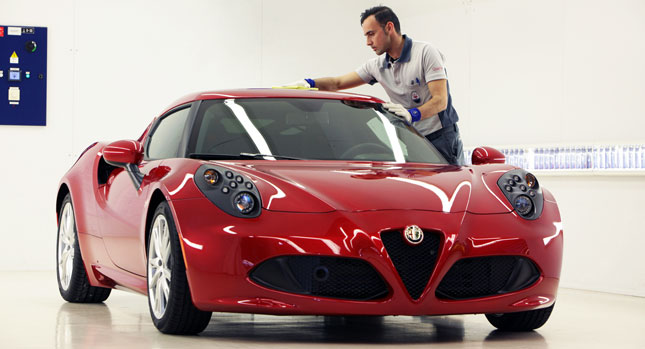The all-new and highly anticipated Alfa Romeo 4C signals the Italian brand’s rejuvenation and its return to the United States this autumn after a hiatus that lasted close to two decades. Alfa’s new small sports car will be built at Maserati’s plant in Modena, just like the 8C Competizione supercar before it.
Designed from the beginning to have a supercar-rivaling weight/power ratio of less than 4 kg/hp, the Alfa Romeo 4C has a total dry weight of just 895 kg (1,973 lbs), which makes it lighter than a city car and one of the lightest production cars in the world. To achieve these figure, engineers used aluminum, steel, lightened SMC (Sheet Moulding Compound) and carbon fiber.
 Alfa Romeo says the secret of the 4C’s lightness and dynamic behavior lays in the use of 10 percent carbon fibre, which represents 25 percent of the 4C overall volume.
Alfa Romeo says the secret of the 4C’s lightness and dynamic behavior lays in the use of 10 percent carbon fibre, which represents 25 percent of the 4C overall volume.
Carbon fiber was chosen for the structural function monocoque that makes up the central, load-bearing cell of the chassis, as the material offers the best weight/stiffness efficiency. The monocoque weighs just 65 kg (143 lbs).
Alfa Romeo has managed to transfer carbon fiber “pre-preg” technology inspired by the Formula 1 to standard manufacturing, with the carmaker saying it is the only brand capable to assure a production of over 1,000 pieces per year.
Aluminum is used for structural parts such as the roof reinforcement cage and the front and rear frameworks. The metal is also used in the hybrid-type front brake discs with aluminium bell and cast iron ring gear, reducing the weight of each disc by up to 2 kg (4.4 lbs).
For the body, Alfa Romeo is using SMC (Sheet Moulding Compound), a low-density and high resistance composite material, which has allowed a 20 percent weight reduction of the body in comparison with the traditional sheet steel.
The bumpers and wings are made of PUR-RIM (injected polyurethane), a material that’s 20 percent lighter than steel and is suitable for creating very complex design elements, such as the 4C wing. Even the car’s windows are made of glass that is 10 percent thinner than the one normally fitted on cars.
Alfa says each 4C is road-tested for 40 km (25 mi) by an experienced test-driver, a practice commonly used for expensive supercars. A maximum of 3,500 cars a year will be built, 1,000 of which are destined for European markets.
European deliveries of the Alfa Romeo 4C will begin in the second half of September 2013, with the U.S. version to be released in November 2013 in Los Angeles. First U.S. deliveries are scheduled for the end of the year. Pricing will be announced closer to launch.
By Dan Mihalascu
PHOTO GALLERY









































